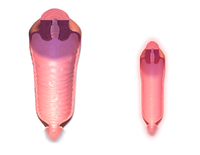
Photo from wikipedia
INTRODUCTION Novel training modalities are being investigated to overcome the challenges associated with learning Retrograde IntraRenal Surgery (RIRS). Consequently, a series of 3D printed models of the upper urinary tract… Click to show full abstract
INTRODUCTION Novel training modalities are being investigated to overcome the challenges associated with learning Retrograde IntraRenal Surgery (RIRS). Consequently, a series of 3D printed models of the upper urinary tract and stones designed for ex-vivo surgical simulation was introduced in 2021. This study aims to provide external validation of the training model and assess its role in the development of surgical skills. MATERIALS AND METHODS A mixed cohort of 20 urologists at different levels of expertise participated in a whole-day live simulation event to examine the model and perform a timed simulation of intrarenal navigation, stone relocation and laser fragmentation. Operative times were recorded and two independent expert endourologists scored the simulations according to a modified Objective Structured Assessment of Technical Skills" (OSATS) scale. Five novice urologists from the cohort performed three further simulations in a subsequent event to assess improvement in surgical skills. RESULTS Face validity was demonstrated with a median score of ≥ 4/5 in in each of the 11 items investigated. Content validity was also successfully reached, with 100% positive impressions with regard to the usefulness for the acquisition of surgical skills. Significant differences were observed among operative times stratified per surgeon experience (all p < 0.0050), thus providing construct validity. Median total OSATS score for novices was 14 (range 8,25) and was found to be significantly different from expected expert performance (p = 0.0010). Repeated simulations by novices led to a progressive reduction of operative times (p=0.0313) and increase in median total OSATS (p =0.0625). CONCLUSION The 3D printed models of upper urinary tract and synthetic training stones for the high-fidelity simulation of each phase of RIRS were validate by this study. The results encourage the usage of the models in simulation courses and the evaluation of their potential role in standardised training curricula.
Journal Title: Journal of endourology
Year Published: 2023
Link to full text (if available)
Share on Social Media: Sign Up to like & get
recommendations!